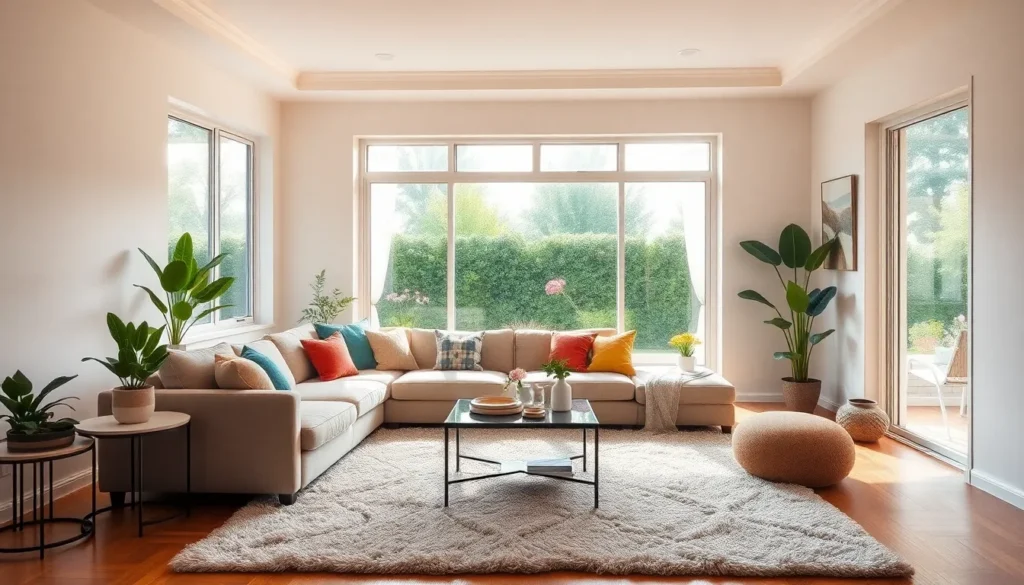We all know that feeling when we walk into our living room and something just feels… off. Maybe it’s the awkward empty corner that stares back at us or the bland walls that desperately need personality. The good news? Transforming your living space doesn’t require a complete overhaul or very costly.
Whether you’re dealing with a cramped apartment or a spacious home that feels incomplete, we’ve discovered countless ways to maximize your living room’s potential. From clever storage answers that double as décor to eye-catching focal points that’ll have your guests asking “where did you get that?” – there’s always room for improvement.
We’re about to share our favorite tried-and-tested ideas that’ll breathe new life into your space. These aren’t just theoretical concepts – they’re practical answers we’ve seen work time and again. Ready to fall in love with your living room all over again? Let’s jump into these game-changing transformations.
Transform Your Spare Bedroom Into a Cozy Second Living Room
Converting your unused bedroom into a second living area opens up countless possibilities for relaxation and entertainment. We’ll show you how to maximize this valuable space with strategic design choices that create comfort and functionality.
Choose Multi-Functional Furniture
Multi-functional pieces serve as the foundation for any successful bedroom to living room conversion. Sleeper sofas provide comfortable seating during the day while offering guest accommodation when needed. Storage ottomans work double duty as footrests and hidden compartments for blankets, books, or games.
Nesting tables offer flexible surface space that we can easily rearrange for different activities like reading, dining, or working. Console tables with built-in storage drawers keep entertainment essentials organized while displaying decorative items on top.
Bookcases with open shelving divide the space naturally while providing display areas for plants, artwork, and personal collections. We recommend choosing pieces that complement your existing home’s style to maintain visual consistency throughout the house.
Create a Defined Layout with Area Rugs
Area rugs establish clear zones within your converted bedroom space and anchor your furniture arrangement. Large rugs measuring 8×10 feet or 9×12 feet work best for creating a cohesive living area that feels intentional rather than improvised.
Position your main seating area entirely on the rug to create visual boundaries and define the conversation zone. Layering smaller accent rugs over a larger neutral base adds depth and texture while maintaining the room’s cohesive feel.
We suggest selecting rugs with patterns or colors that complement your existing decor scheme. Neutral backgrounds with subtle geometric patterns work well for contemporary spaces, while traditional Persian or oriental designs enhance classic interiors.
Add Warm Lighting for Ambiance
Layered lighting transforms your spare bedroom into an inviting retreat that rivals your main living room. Table lamps placed on side tables or console units provide task lighting for reading while creating cozy pools of warm light.
Floor lamps positioned in corners eliminate harsh shadows and brighten areas that overhead fixtures can’t reach effectively. String lights or LED strips behind furniture pieces add soft backlighting that makes the space feel larger and more welcoming.
We recommend installing dimmer switches on existing overhead lights to control brightness levels throughout the day. Candles or battery operated LED candles on shelves and tables introduce flickering warmth that makes evening relaxation even more enjoyable.
Convert Your Dining Room Into a Flexible Living Space

Dining rooms often remain unused except for special occasions, making them prime candidates for transformation. We can create a dual-purpose space that serves both dining and living functions with strategic furniture choices.
Select Convertible Dining Tables
Convertible dining tables maximize space efficiency while maintaining dining functionality. Drop-leaf tables fold down to create compact console surfaces for everyday use, then expand to accommodate dinner guests when needed. Expandable dining tables with built-in leaves store additional table sections internally, eliminating the need for separate leaf storage.
Height-adjustable tables offer remarkable versatility for multiple activities. These pieces transition from coffee table height for casual lounging to standard dining height for meals. Counter-height tables provide comfortable workspace surfaces for laptops and projects while doubling as casual dining spots.
Nesting table sets create flexible surface arrangements throughout the room. Individual tables separate to provide side tables for seating areas, then stack together for compact storage. Glass-topped convertible tables maintain visual openness while offering sturdy surfaces for both dining and living room activities.
Use Modular Seating Answers
Modular sectional pieces adapt to various room configurations and occasions. Individual ottoman units combine to form larger seating arrangements for entertaining, then separate into flexible accent pieces for daily use. Stackable floor cushions store vertically in closets but create casual seating for large gatherings.
Bench seating provides dining functionality without sacrificing living space aesthetics. Upholstered dining benches slide under tables when not needed, then pull out to create additional seating for movie nights. Storage benches hide linens, games, or seasonal items while serving as extra seating or coffee table surfaces.
Poufs and ottoman cubes offer lightweight seating mobility throughout the space. These pieces move easily between dining and living zones as needed. Cube ottomans with removable tops reveal hidden storage compartments for dining linens, games, or electronic accessories.
Incorporate Storage-Friendly Décor
Built-in storage answers eliminate clutter while improving room aesthetics. Wall-mounted floating shelves display decorative items and books without consuming floor space. Custom banquette seating along walls includes lift-up storage compartments for linens, board games, and seasonal decorations.
Multi-functional furniture pieces serve dual storage and décor purposes. Storage ottomans hide remote controls, magazines, and throw blankets while providing extra seating or footrests. Console tables behind sofas offer surface space for lamps and décor while concealing dining linens in drawers below.
Decorative baskets and containers organize essentials while maintaining visual appeal. Woven baskets store throw pillows, blankets, and children’s toys in attractive containers that complement living room décor. Glass apothecary jars display small dining accessories like napkin rings and candles as decorative elements rather than hidden clutter.
Design a Basement Living Room for Family Entertainment

Basements offer incredible potential for creating dedicated family entertainment spaces that don’t compete with your main living areas. We’ll show you how to transform this underutilized space into a vibrant hub where your family can relax and play together.
Address Moisture and Lighting Concerns
Moisture control forms the foundation of any successful basement living room project. We recommend installing a dehumidifier to prevent moisture buildup and ensure proper ventilation throughout the space. Mold prevention becomes effortless when you maintain consistent humidity levels below 50%.
Lighting answers dramatically impact the ambiance of your basement entertainment area. Combine overhead lighting with table lamps and floor lamps to eliminate dark corners and create an inviting atmosphere. LED lighting offers energy efficiency while providing the bright illumination your basement needs to feel welcoming rather than cave-like.
Install Comfortable Flooring Options
Warm flooring materials like hardwood, carpet, or laminate add comfort and visual appeal to basement spaces. These options create a cozy foundation that encourages family members to spend time in the area without feeling like they’re in a cold, unwelcoming basement.
Moisture-resistant flooring addresses the unique challenges basements present. Waterproof options like vinyl or tile provide durability while protecting against potential water issues. We suggest choosing flooring that combines moisture resistance with comfort to create the best possible environment for family activities.
Create Separate Activity Zones
TV and entertainment areas serve as natural focal points for family gatherings. Designate a exact space for your large TV with comfortable seating arranged to optimize viewing angles. This zone becomes the heart of your basement living room where everyone can enjoy movies and shows together.
Game zones encourage family interaction through hands-on activities. Include a table for board games or install a pool table to create opportunities for friendly competition. These dedicated play areas give family members reasons to choose the basement over other entertainment options.
Bar or snack areas help socializing and make refreshments easily accessible during gatherings. Add a small bar setup or snack station to keep drinks and treats within reach. This convenience factor makes your basement living room feel complete and self-contained for extended family time.
Utilize Your Attic Space as a Private Retreat Living Room
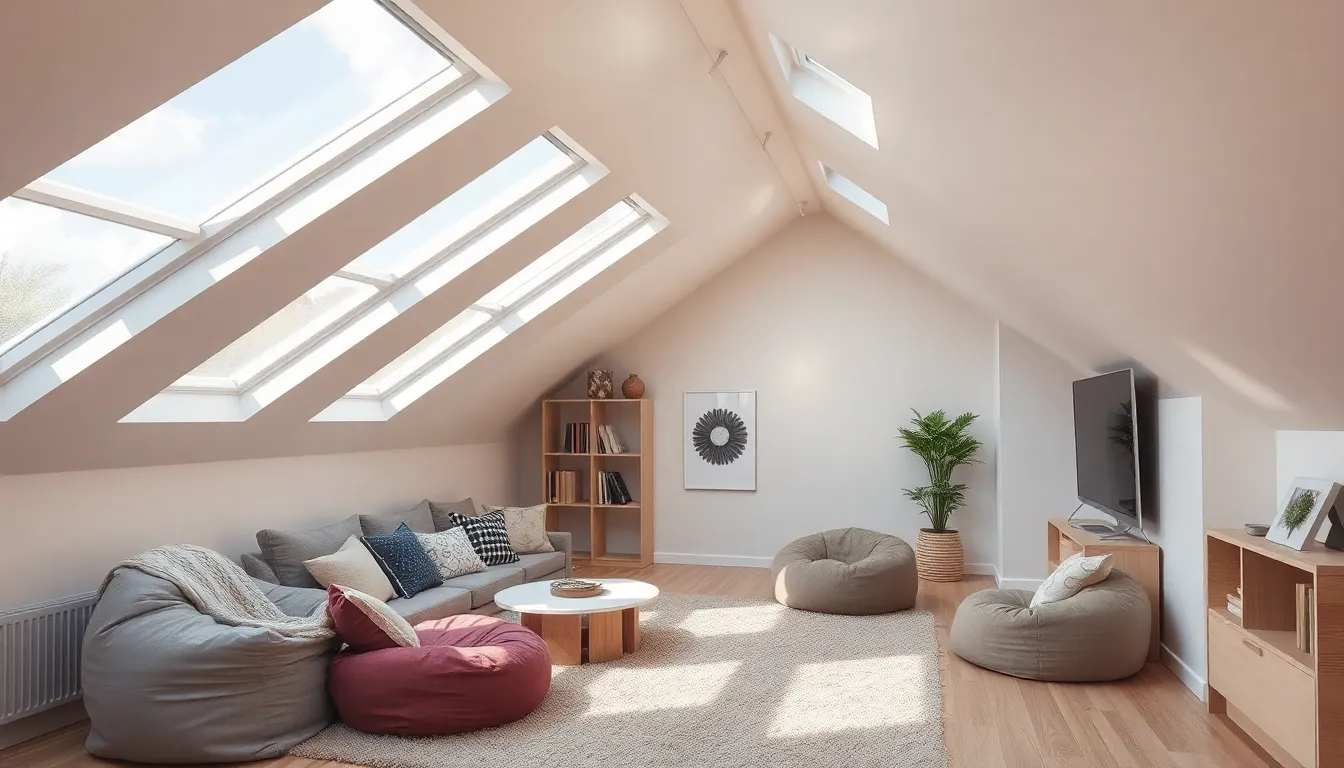
Converting your attic into an extra living room creates a secluded sanctuary away from the main living areas. We’ll explore how to transform this often-overlooked space into a cozy retreat that maximizes comfort and functionality.
Ensure Proper Insulation and Ventilation
Establishing proper insulation forms the foundation of any successful attic conversion. We recommend installing high-quality insulation materials to maintain comfortable temperatures year-round while reducing energy costs significantly. Temperature regulation becomes crucial in attic spaces since they’re naturally prone to extreme heat in summer and cold in winter.
Ventilation systems prevent moisture buildup that can lead to mold and structural damage. Installing windows or strategically placed vents improves airflow throughout the space and creates a healthier environment. Cross-ventilation works best when we position intake vents at the eaves and exhaust vents near the ridge.
Air circulation enhancement through ceiling fans or HVAC extensions ensures consistent comfort levels. We suggest consulting with professionals to determine the best ventilation strategy for your exact attic layout and local climate conditions.
Work with Slanted Ceilings Creatively
Slanted ceilings offer unique design opportunities rather than limitations when we approach them strategically. Custom shelving units fit perfectly under angled walls and provide essential storage while maintaining the room’s aesthetic appeal. Built-in storage answers maximize every inch of available space without creating visual clutter.
Cozy reading nooks emerge naturally in areas where ceiling height decreases. We can create intimate seating areas with low-profile furniture like floor cushions or bean bags that complement the slanted architecture. These spaces become perfect spots for relaxation and contemplation.
Furniture placement requires thoughtful consideration of ceiling angles and walking paths. Low-profile sofas and coffee tables work best in areas with reduced headroom while taller furniture fits comfortably under peak sections. Strategic arrangement creates functional zones that feel intentional rather than constrained.
Add Skylights for Natural Light
Skylights transform dark attic spaces into bright and welcoming living areas filled with natural illumination. We recommend installing energy-efficient skylights that provide abundant daylight while maintaining proper insulation values. Natural light reduces dependence on artificial lighting during daytime hours and creates an open, airy atmosphere.
Positioning considerations include sun path analysis and furniture placement to maximize light distribution throughout the room. South-facing skylights provide consistent illumination while north-facing options offer gentler, more even lighting. Multiple smaller skylights often work better than single large units for balanced light coverage.
Ventilating skylights serve dual purposes by providing both natural light and improved air circulation. These units open to release hot air during summer months and can be controlled remotely for convenience. Weather protection features ensure durability and prevent water infiltration during storms.
Light control options like blinds or shades allow us to adjust brightness levels based on activities and time of day. Automated systems respond to changing light conditions and maintain optimal comfort levels throughout the day.
Create an Outdoor Living Room Extension
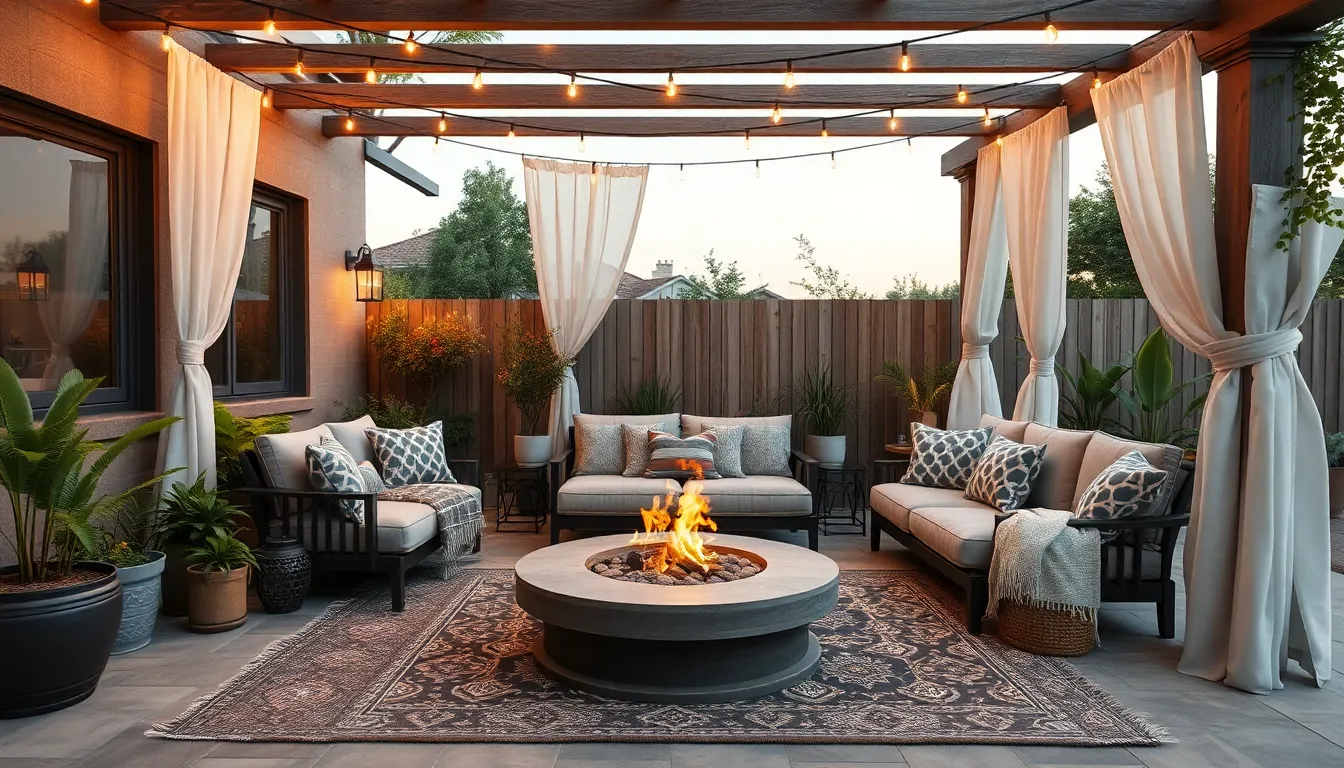
Building on our indoor transformation ideas, we can extend our living space beyond the walls of our home. Creating an outdoor living room provides a gathering spot for families and guests while maximizing our property’s utility and appeal.
Invest in Weather-Resistant Furniture
Weather-resistant furniture forms the foundation of any successful outdoor living room extension. Teak, metal, and all-weather wicker materials withstand sun, rain, and temperature changes while maintaining comfort and aesthetics year-round. Outdoor sofas and sectionals anchor seating areas and encourage conversation among family members and guests.
Coffee tables made from durable materials provide functional surfaces for drinks and snacks during outdoor gatherings. Chairs crafted from weather-resistant materials offer flexible seating options that we can rearrange based on our entertainment needs. These furniture pieces require minimal maintenance while delivering maximum comfort throughout all seasons.
Install Adequate Lighting and Heating
Proper lighting extends our outdoor living room’s usability well into the evening hours. String lights create ambient warmth and visual interest when draped between pergola posts or along fence lines. Lanterns provide portable illumination that we can move to different zones as needed.
Recessed fixtures offer permanent lighting answers that highlight exact seating areas or architectural features. Fire pits serve dual purposes by providing both warmth and a natural gathering point for cooler months. Outdoor heaters ensure our comfort during fall and winter entertaining sessions.
Heated seating pads transform regular outdoor furniture into cozy retreat spots during chilly evenings. These heating elements make our outdoor living room functional throughout more months of the year.
Use Outdoor Rugs and Curtains for Definition
Outdoor rugs anchor our seating arrangements and add texture to hard surfaces like concrete patios or wooden decks. These decorative elements help define separate zones within our outdoor space, creating distinct areas for lounging versus dining. Rugs provide comfort underfoot while protecting outdoor furniture from direct ground contact.
Curtains hung from pergolas offer shade during bright afternoon hours and privacy from neighboring properties. Posts between seating areas can support curtain panels that create intimate conversation nooks. These fabric elements add a stylish finishing touch that enhances our sense of having a true living room outdoors.
Strategic placement of both rugs and curtains transforms unused backyard or patio space into inviting, functional extensions of our home’s interior living areas.
Repurpose Your Home Office Into a Dual-Function Living Area
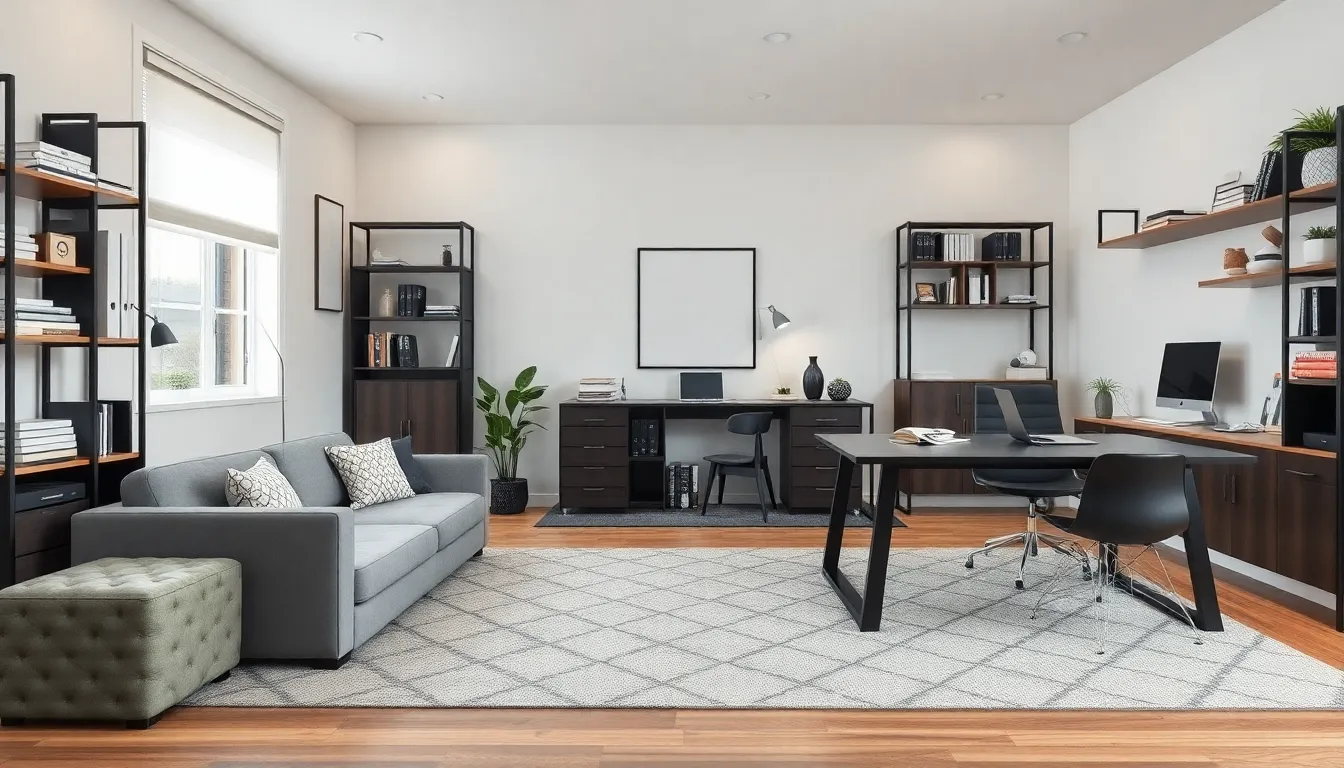
Converting your home office into a versatile living space creates opportunities for both productivity and relaxation. This transformation allows us to maximize square footage while maintaining the functionality we need for remote work and daily life.
Choose Furniture That Serves Multiple Purposes
Multifunctional furniture pieces serve as the foundation for any successful dual purpose room conversion. We recommend investing in a storage ottoman that doubles as extra seating during video calls and provides hidden compartment space for office supplies or throw blankets.
A sofa bed transforms your workspace into an instant guest room or afternoon napping spot. These convertible pieces eliminate the need for separate furniture while maximizing floor space in smaller rooms.
Consider a large desk that moonlights as a dining table for evening meals or family game nights. Murphy desks fold against the wall when not in use, instantly converting your office back into a traditional living area.
Modular shelving units adapt to changing needs throughout the day. These versatile storage systems can display books during work hours and showcase decorative items when you’re entertaining guests.
Organize with Stylish Storage Answers
Storage answers keep your dual function space organized while maintaining visual appeal. Built-in cabinets provide designated spots for office equipment that can be hidden when you’re using the room for relaxation.
Wall-mounted shelves use vertical space effectively without cluttering floor areas. We suggest installing floating shelves at varying heights to create visual interest while storing both work materials and living room accessories.
Hidden storage units maintain a clutter-free environment essential for both productive work sessions and comfortable leisure time. Stylish storage baskets can hold office supplies during the day and remote controls or magazines in the evening.
Bookshelves serve double duty by organizing work references alongside personal reading collections. These functional pieces create natural room dividers that separate work zones from relaxation areas.
Maintain Professional Elements When Needed
Professional elements ensure your space remains suitable for video conferences and client meetings. A dedicated workspace area with proper lighting and a neutral background maintains credibility during important business calls.
Smart boards or wall-mounted monitors integrate seamlessly into living room decor while providing presentation capabilities when needed. These technology answers can display family photos or artwork when not being used for work purposes.
Comfortable seating in a designated meeting corner creates an inviting atmosphere for virtual collaborations. We recommend positioning ergonomic chairs near windows for natural lighting that flatters during video calls.
Projectors offer flexible entertainment and presentation options that adapt to both work and leisure activities. These devices can display business presentations during the day and movie nights in the evening, making them perfect for dual function spaces.
Transform Your Garage Into a Year-Round Living Space

Converting your garage offers one of the most cost-effective ways to add important square footage to your home. We’ll walk you through the essential steps to create a comfortable, functional living space that you can enjoy throughout every season.
Improve Insulation and Climate Control
Proper insulation serves as the foundation for any successful garage conversion. We recommend installing insulation in both the walls and ceiling to maintain consistent temperatures while reducing external noise from traffic or neighbors. Most garages lack adequate insulation since they weren’t originally designed for living spaces.
Heating and cooling systems ensure year-round comfort in your new living area. We suggest installing a dedicated HVAC system or extending your existing system to reach the converted space. Mini-split systems work particularly well for garage conversions because they’re energy-efficient and don’t require extensive ductwork modifications.
Temperature control becomes crucial during extreme weather seasons. We’ve found that properly insulated garage conversions can maintain comfortable temperatures even when outside conditions are harsh, making the investment in quality climate control systems worthwhile.
Install Proper Flooring and Wall Treatments
Durable flooring transforms the cold, concrete garage floor into a welcoming living surface. We recommend hardwood or laminate flooring that complements your home’s existing aesthetic while providing warmth underfoot. These materials also handle moisture better than carpet and are easier to maintain.
Wall treatments create a cozy atmosphere that makes the space feel like a true living room. We suggest using textured paint or wallpaper to add visual interest and warmth to what were once utilitarian garage walls. Consider colors that make the space feel larger and more inviting.
Moisture barriers protect your investment from potential water damage. We always recommend installing proper vapor barriers behind wall treatments, especially in areas prone to humidity or occasional moisture issues.
Add Windows or Skylights for Natural Light
Large windows bring natural light into the space while creating visual connections to your outdoor areas. We suggest installing windows wherever possible to eliminate the enclosed, basement-like feeling that converted garages can sometimes have. Natural light makes any space feel more spacious and welcoming.
Skylights introduce additional natural light in areas where wall windows aren’t feasible. We recommend energy-efficient skylights that can significantly brighten the space, especially in garages without external walls suitable for traditional windows. Modern skylights also provide excellent ventilation options.
Strategic placement of light sources maximizes the impact of your natural lighting investments. We’ve found that combining windows with skylights creates a well-lit environment that feels open and airy throughout the day, reducing the need for artificial lighting and lowering energy costs.
Design a Sunroom or Enclosed Porch Living Area
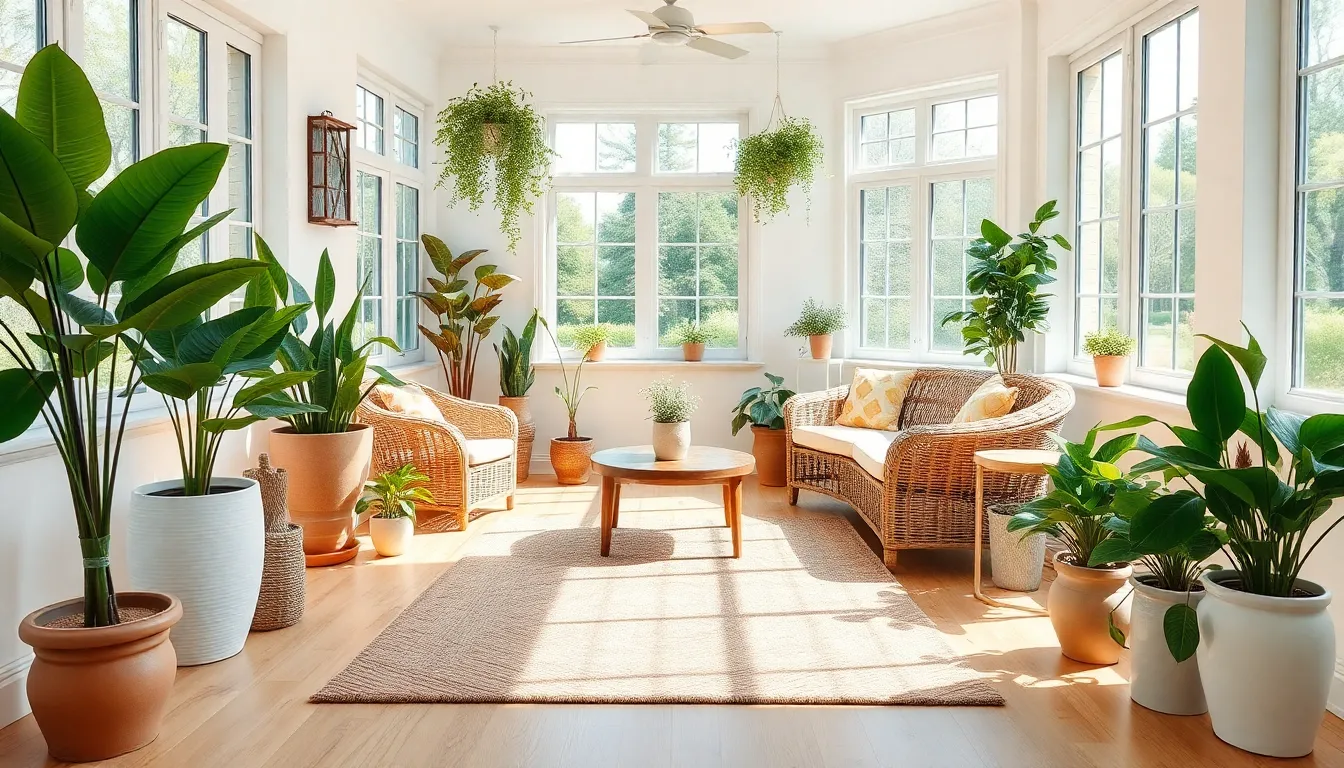
Building on our exploration of transforming various spaces, a sunroom or enclosed porch offers one of the most rewarding opportunities to create an extra living room that seamlessly blends indoor comfort with outdoor beauty. This bright, inviting space connects your home’s interior with the natural industry outside while providing year-round usability.
Select Furniture That Handles Temperature Changes
Choosing the right furniture for your sunroom requires careful consideration of temperature fluctuations throughout the seasons. Natural fibers and breathable fabrics perform exceptionally well in these spaces, adapting comfortably to both warm summer days and cooler winter months.
Light-toned hardwoods like white oak, maple, or hickory create an instantly cooler feel compared to darker wood varieties that tend to absorb and retain heat. These lighter woods naturally reflect sunlight rather than absorbing it, helping maintain comfortable temperatures even during peak sun exposure.
Prioritizing pieces with reflective finishes makes a important difference in temperature management. Shiny or polished surfaces bounce light and heat away from the furniture, while matte finishes tend to absorb warmth and can make seating uncomfortably hot during sunny periods.
Wicker and rattan furniture with removable cushions offer excellent versatility for seasonal adjustments. You can easily swap out heavier winter cushions for lighter summer fabrics, ensuring comfort throughout the year while maintaining your sunroom’s aesthetic appeal.
Incorporate Plants and Natural Elements
Plants transform any sunroom into a living, breathing extension of your garden while adding visual warmth and natural beauty to the space. Real plants thrive in sunrooms due to abundant natural light, though high-quality faux plants work equally well if maintenance becomes a concern.
Textured rugs anchor your seating areas while introducing organic patterns and warm tones that complement your plant selections. These rugs create defined zones within the larger space and add crucial comfort underfoot, especially on hard flooring surfaces.
Warm-toned wood finishes throughout your sunroom create cohesive connections between furniture pieces and natural elements. These finishes echo the organic qualities of your plants while maintaining the space’s fresh, airy atmosphere.
Textural accessories like woven baskets, natural fiber throws, and ceramic planters enhance the organic feel while providing practical storage and comfort answers. These elements work together to create layers of texture that make your sunroom feel both cozy and connected to nature.
Use Light, Airy Color Schemes
Color selection plays a crucial role in maintaining your sunroom’s open, comfortable atmosphere throughout changing seasons. Nature-inspired tones like soft whites, gentle greens, light blues, and warm beiges create an expansive feeling while keeping the space visually cool and inviting.
These light neutrals reflect natural light throughout the day, maximizing the brightness that makes sunrooms so appealing. They also provide a versatile backdrop for seasonal decorating, allowing you to add pops of color through cushions, throws, and accessories without overwhelming the space.
Warm lighting with bulbs in the 2700-3000K range balances cooler color tones during evening hours and cloudy days. This lighting temperature adds inviting softness without competing with natural daylight when it’s available.
Avoiding heavy, dark colors prevents your sunroom from feeling compressed or overly warm during intense sun exposure. Light colors visually expand the space while maintaining the cool, refreshing atmosphere that makes these rooms perfect retreats from both indoor stuffiness and outdoor extremes.
Conclusion
We’ve explored countless ways to expand your living space without very costly or moving to a new home. From transforming unused bedrooms and basements to creating outdoor sanctuaries and repurposing garages these strategies prove that extra living areas are within reach for every homeowner.
The key lies in seeing potential where others see obstacles. Whether you’re working with slanted attic ceilings or a dusty basement every space offers unique opportunities for creativity and comfort.
Remember that successful room transformations focus on three essential elements: proper lighting comfortable seating and smart storage answers. These fundamentals work together to create inviting spaces that your family will actually want to use.
Start with one room that excites you most and begin implementing these ideas today. Your perfect extra living space is waiting to be discovered right within your own home.
Frequently Asked Questions
What are the most cost-effective ways to transform my living room?
You don’t need expensive renovations to transform your living room. Focus on clever storage solutions that double as decor, create striking focal points with artwork or accent walls, and rearrange existing furniture for better flow. Adding area rugs, layered lighting, and strategic color accents can dramatically change the space without breaking the bank.
How can I convert my spare bedroom into a functional second living room?
Use multi-functional furniture like sleeper sofas and storage ottomans to maximize functionality. Define different zones with area rugs, layer smaller rugs for texture, and incorporate warm lighting with table lamps, floor lamps, and dimmer switches. This creates a cozy space perfect for relaxation and entertainment.
What’s the best way to repurpose my unused dining room?
Transform your dining room with convertible or height-adjustable tables that serve multiple functions. Add modular seating like sectional pieces and stackable floor cushions for flexibility. Incorporate storage-friendly décor such as built-in solutions and multi-functional furniture to eliminate clutter while maintaining style.
How do I create a comfortable basement living room?
Start with moisture control by installing dehumidifiers and proper ventilation. Combine overhead and ambient lighting for a welcoming atmosphere. Choose moisture-resistant flooring materials and create separate activity zones for TV viewing, games, and dining to make the space a vibrant family hub.
What should I consider when converting my attic into a living space?
Ensure proper insulation and ventilation for temperature control and moisture prevention. Use slanted ceilings creatively with custom shelving and reading nooks. Add skylights for natural light and air circulation. Energy-efficient options will enhance both illumination and ventilation while reducing energy costs.
How can I create an outdoor living room extension?
Invest in weather-resistant furniture like teak or all-weather wicker for durability. Add adequate lighting with string lights and heating solutions like fire pits for year-round use. Use outdoor rugs and curtains to define spaces and add style, transforming your patio into an inviting home extension.
Is it possible to combine a home office with a living area?
Yes, use multifunctional furniture like storage ottomans and sofa beds to maximize space efficiency. Organize with stylish storage solutions such as built-in cabinets and wall-mounted shelves. Maintain professional elements for video calls by creating dedicated workspace areas with seamlessly integrated technology.
What’s involved in converting a garage into a living space?
Focus on proper insulation and climate control with dedicated HVAC or mini-split systems. Install durable flooring like hardwood or laminate and use textured paint or wallpaper for cozy walls. Add windows or skylights for natural light to enhance openness and reduce dependence on artificial lighting.
How do I design a sunroom as an additional living area?
Select furniture that handles temperature changes, using natural fibers and light-toned hardwoods. Incorporate plants and natural elements for enhanced aesthetics and warmth. Use light, airy color schemes to create an inviting atmosphere that blends indoor comfort with outdoor beauty throughout all seasons.

